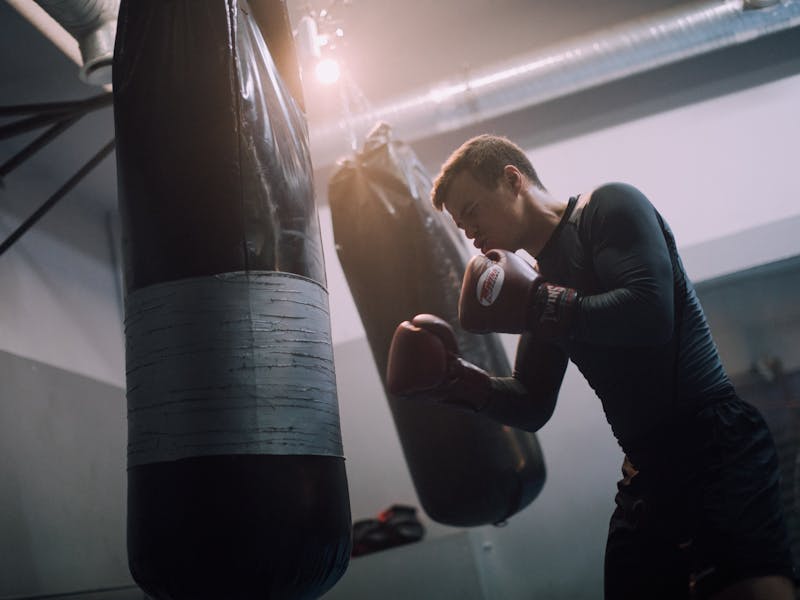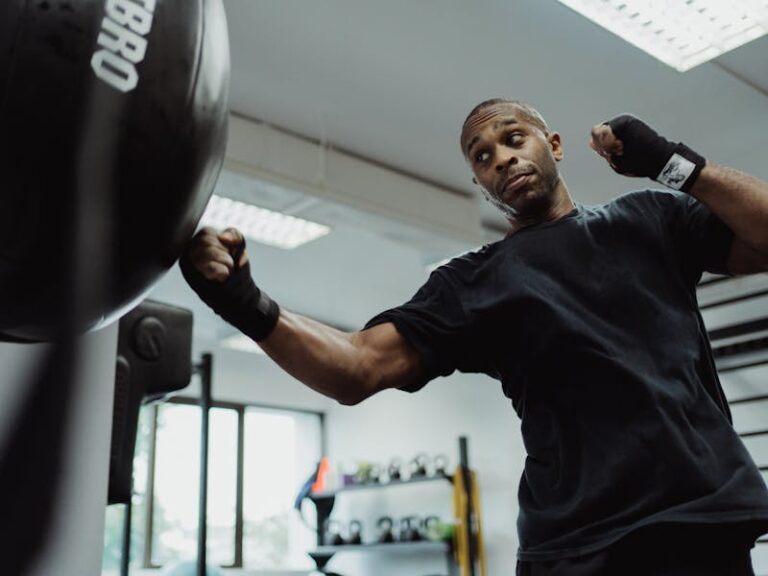Many people interested in boxing training wonder whether you can learn boxing without sparring and being hit, and if so, how?
Yes, you don’t need to spar to learn how to box. Skill-specific drills on the bag, shadowboxing, or hitting the pads are enough for a student to develop proper technique, and improve fitness.
But in order to learn how to apply these moves in a real fight and train your body and mind for combat, you would have to do partner drills or light sparring at least.
Let’s further explore by going deeper into how you can learn boxing without sparring, the pros and cons of this approach, as well as alternative methods you can use instead.
Can You Learn Boxing Without Sparring?
Dedicated practitioners can expect to develop proper boxing techniques without participating in sparring sessions. Doing bag work, pads, and other drills, they can develop footwork, movement, correct punching skills, and learn how to mix it all together.
On top of that, this approach enables you to improve your fitness and get in top shape in a short time. But this is where your progression stops.

In order to learn how to fight and apply these skills in real combat, you would need to do partner drills and spar on a regular basis. You can expect to develop timing, feeling for the range, or fighting instincts unless you put your skills on the test against a fully resisting opponent who strikes back.
The same stands for physical and mental conditioning needed for real fighting. You need to feel punches to condition your body, prevent the mind from panicking, and learn how to stay calm under pressure.
Overall, the skills practitioners learn without sparring may help them in a self-defense scenario to a certain degree. But they need to simulate real combat with their partner if their goal is a competition or an advanced self-defense skill set.
Is Sparring Really Dangerous?
The risk of injuries is mainly based on the intensity of the exchanges and your goals. Light sparring is usually safe and more than enough for skill development while hard sparring is reserved for competitors.
First, boxers wear padded protective gear. This includes gloves, headgear, mouth guard, and groin guard. Next, the risk is further decreased with the controlled intensity and contact. For instance, light contact with 50% power is used for skill development and carries a much lower injury risk. Even if you get hurt, these are usually minor injuries.

As a practitioner focused on learning, you shouldn’t be too worried about how dangerous is boxing. The combination of protective gear, light contact, and respectful approach is more than enough to keep both parties safe, making boxing not dangerous for beginners.
According to studies, practitioners suffer 1 injury per 772 hours of training time indicating that the risks are, indeed, quite low.
What Are The Benefits of Sparring?
Sparring offers a unique opportunity to put your skills to the test, gain valuable experience, and elevate your skills to new heights. In this section, we will explore the benefits of boxing sparring for advancing your skills.
- Physical preparation for real combat
One of the primary advantages of sparring is that it allows boxers to gain practical experience in a controlled environment. While shadowboxing, bag work and pad work are good for skill development, sparring provides the real-life application of these skills.
Being skilled and proficient on the bag does not mean you are capable of performing the same way against the moving target who is striking back.
Through actual combat scenarios with fellow boxers, you can refine your timing, feeling for distance, accuracy, training your mind, and many other skills.
- Mental preparation for real combat
In addition to physical benefits, sparring also plays a vital role in mental conditioning. It teaches you how to stay composed under pressure and make split-second decisions instinctively.
As you face different opponents with varying strengths and weaknesses during sparring sessions, you develop adaptability and strategic thinking skills that are essential for success inside the ring.
- Improves your defensive work
Sparring enables boxers to enhance their defensive capabilities. By engaging in controlled yet dynamic exchanges with opponents, you learn how to effectively evade punches while maintaining proper footwork and head movement.
This not only improves your defensive prowess but also enhances your overall ring awareness.
How to Overcome the Fear of Sparring?
Fear of sparring is natural and you can overcome it with the right mindset and preparation. Practitioners afraid of physical exchanges should, at least try to use the following methods to overcome this fear because many of them end up succeeding.
The key to beating the fear of sparring is to gradually expose yourself to controlled and safe sparring situations. This approach enables you to try sparring and prepare your mind and body for it by doing it at your own pace.
- Start with live drills and touch sparring — Start by doing drills with a trusted partner or coach who can provide guidance and support. This helps you become familiar with the movements, techniques, and rhythm of sparring without feeling overwhelmed.
- Be patient — Take the time to understand the fundamentals. Practice regularly, and seek feedback from experienced practitioners or coaches. Do not put yourself right into the fire. Even if you feel the fear is going away, do not overdo it.
- Visualize the fear — Visualize successful sparring sessions. Imagine yourself performing well under pressure. Develop a positive mindset by reminding yourself of your progress, strengths, and goals.
Train in a supportive environment
Lastly, it’s essential to create a supportive training environment where you feel comfortable expressing your concerns or fears. Communicate openly with your training partners and instructors about any anxieties you may have regarding sparring. They can provide guidance, encouragement, and reassurance throughout your journey.
Alternative Ways of Learning Boxing Without Sparring
There are alternative ways to enhance your boxing abilities. The following methods you can find listed below can help you develop technique, speed, power, and endurance without the need for direct sparring.
- Touch Sparring
“Boxing touch sparring” typically refers to a form of sparring or training in boxing where the emphasis is on light or controlled contact. Unlike full-contact sparring where fighters throw punches with more power and intent to simulate a real match, touch sparring involves tapping or lightly making contact with your opponent.
Touch sparring can be an effective tool for developing a boxer’s skills in a safer environment. It’s particularly valuable for honing specific aspects of technique, such as precision, timing, and distancing. It’s often used in training scenarios for beginners or during specific skill development sessions.
- Shadowboxing
One of the most effective methods is shadowboxing. This solo training technique allows you to practice your footwork, punches, and defensive movements in front of a mirror or in an open space. Shadowboxing helps improve your form and coordination while allowing you to visualize an opponent.
- Bag work
Another valuable training tool is bag work. Hitting a heavy bag or a speed bag can help refine your punching technique and build power and accuracy. Bag work also improves hand-eye coordination and stamina as you simulate the intensity of a real fight.
- Hitting the pads
Pad work is another excellent way to sharpen your boxing skills without sparring. Working with a coach or training partner holding focus mitts allows you to practice combinations, timing, and precision strikes. It also helps develop defensive maneuvers as you react to their movements.
How To Spar Without Injuries?
The goal of sparring is to improve skills and technique, not to cause harm or sustain injuries. To spar without injuries, it is crucial to prioritize safety at all times which includes:
- Wearing protective gear
- Communicating with the partner
- Prioritizing technique over power
- Avoiding cheap shots to sensitive areas
- Train in a legitimate school that prioritizes safety
This can be achieved by following a few key guidelines. First and foremost, always wear the proper protective gear, including mouthguards, headgear, gloves, and groin protectors. These items are designed to minimize the risk of serious injury during sparring sessions.
Communication is key. Establish clear communication and boundaries with your sparring partner. Agree on the intensity level and ensure that both participants are comfortable with it. Openly discuss any pre-existing injuries or conditions that may affect the sparring session.
Proper technique and control are also paramount in safe sparring. Focus on precision rather than power when throwing punches or executing techniques. This will reduce the likelihood of accidental injuries caused by excessive force.
Lastly, listen to your body and take breaks when needed. Overtraining can lead to fatigue and increased vulnerability to injuries during sparring sessions. Allow yourself enough time for rest and recovery between training sessions.
How To Learn Boxing Quickly? (Expert Tips)
Can you learn boxing at home?
Yes, you can learn boxing at home with the right resources and dedication. While it may not be the same as training in a pro boxing gym, there are several ways to develop your skills and technique from the comfort of your own home.
There are numerous platforms and websites that offer comprehensive guides on boxing techniques, footwork, combinations, and defensive strategies. These resources can provide valuable insights and demonstrations that allow you to learn and practice various aspects of boxing.
Additionally, investing in some basic equipment such as a punching bag, hand wraps, gloves, and a jump rope can greatly enhance your training experience at home. These tools will enable you to practice punches, improve your speed and agility through skipping exercises, and simulate sparring sessions with the punching bag.
It’s important to note that while learning at home can be beneficial for developing fundamental skills and improving fitness levels, it’s always recommended to eventually seek guidance from a qualified coach or join a local boxing gym for proper technique refinement and sparring opportunities.
Why Boxing Sparring is Important? (Key Benefits)


